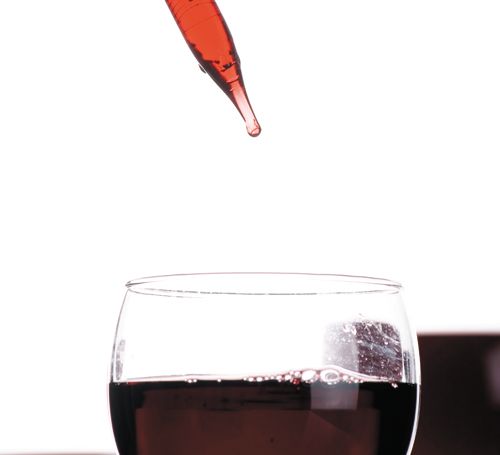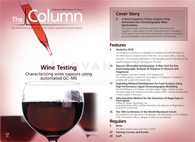A Novel Snapshot of Wine Analysis Using Automated Gas Chromatography–Mass Spectrometry
The Column spoke to Ricardo Lopez from the University of Zaragoza, in Spain, about his work characterizing the composition of the vapours from wine during consumption using an automated gas chromatography–mass spectrometry (GC–MS) technique.
Photo Credit: Shebeko/Shutterstock.com

The Column spoke to Ricardo Lopez from the University of Zaragoza, in Spain, about his work characterizing the composition of the vapours from wine during consumption using an automated gas chromatography–mass spectrometry (GC–MS) technique. -Interview by Kate Mosford
Q. What led your group to develop a new method to characterize the composition of the vapours from wine during consumption using an automated gas chromatography–mass spectrometry (GC–MS) technique (1)?
A: Our group has been studying wine flavour for more than 25 years. During this period, we have obtained plenty of data regarding wine volatile composition, but we have come to the realization that the data coming from the liquid phase of wine only explains one part of the sensory perception. What these data lack is the influence of the wine matrix on the release of the volatile compounds. This is the reason we decided to develop a method that was able to provide information about the real headspace composition.
Q. What is novel about your approach?
A: There are several reports proposing headspace techniques for wine aroma analysis (2–6), but what is novel about our approach is that our method is able to provide a “snapshot” of the headspaces emanated from wine in conditions close to those found during wine tasting.
Q. Could you also talk a little about the compositional changes in the wine during the time that the wine is kept in the glass during consumption. What were your findings?
A: With our method (1), we have found that there are different patterns of release to the headspace depending on the chemical families. There are compounds whose concentration in the headspace remain unchanged-this is the case for polar or moderately polar compounds such as major alcohols. There are other compounds whose concentration in the headspace decay. This is clearly the case for ethyl esters or very volatile compounds, such as dimethyl sulphide and methanethiol. Finally, there are compounds whose behaviour is wine-dependent. For example, carbonyl compounds evolved with time differently in each wine and we attributed this to the different levels of sulphites in the wines.
Q. What were the analytical challenges that you encountered and how did you overcome them?
A: Because we decided from the beginning that we wanted to take a “snapshot” of headspace composition, the amount of headspace we could trap was very limited. This had repercussions on the sensitivity of the method. Also, we wanted the method to provide data about a wide range of concentration and volatilities but with a temperature close to that of wine when tasting. Finally, we reached a compromise and set the wine temperature at 30 ºC, and using single ion monitoring mass spectrometry (SIM-MS) detection we were able to obtain data about low volatility compounds, such as 4-ethylphenol.
Q. What are the factors that need to be considered when selecting an analytical method for wine analysis? Why is GC–MS your method of choice?
A: I think the most important thing to have in mind is that when you are studying wine flavour there are always at least 35 compounds that will be above their sensory threshold. But the problem is that these compounds belong to different chemical families and their concentrations expand for more than 10 orders of magnitude. For example, ethanol is important at 13% but 3-mercaptohexyl acetate also plays a role at a few ng/L. This means that there is no single method of analysis able to analyze all relevant compounds simultaneously. For example, in our laboratory we use around seven different methods of analysis of wine depending on our target analytes.
Q. What can the emanated vapours reveal about a wine?
A: Drinking wine is a slow process. Wine enthusiasts like to spend time tasting and enjoying it, therefore the wine remains in the glass for some time. During this time, we notice that there is a change in the aroma of wine. This change in the sensory perception should be related to the change in composition of the vapours emanating from that wine.
Q. What does this method offer over other existing methods?
A: I think the novelty of our method comes from the information it provides about the headspace. Other methods have used headspace to quantify wine volatiles (2–6), but our method is different because it gives information about the real composition of the headspace, not about the liquid phase like previous methods.
Q. What is your group working on next?
A: We have applied this method to study the influence of oxygen and glass swirling while tasting. Also, we are in the process of combining this chemical information with the simultaneous tasting of the wine.
References
- W. Yan, R. Lopez, and V. Ferreira, Journal of Chromatography A1534, 130–138 (2018).
- M. Salinas, G. Alonso, and F. Esteban-Infantes, J. Agric. Food Chem.42, 1328–1331 (1994).
- C. Garcia-Jares, S. García-Martín, and R. CelaâTorrijos, J. Agric. Food Chem.43, 764–768 (1995).
- M. Ortega-Heras, M.L. González-SanJosé, and S. Beltrán, Anal. Chim. Acta458, 85–93 (2002).
- M. Aznar and T. Arroyo, J. Chromatogr. A1165, 151–157 (2007).
- A. Marquez, M.P. Serratosa, J. Merida, L. Zea, and L. Moyano, Talanta 123, 32–38 (2014).

Ricardo Lopez has been a reader at the University of Zaragoza, in Spain, since 2007. He holds a Ph.D. in analytical chemistry with research interests and publications primarily in the development and application of analytical methods that are useful in the field of flavour chemistry.
E-mail: riclopez@unizar.esWebsite:http://laae.unizar.es/EN/

Analytical Challenges in Measuring Migration from Food Contact Materials
November 2nd 2015Food contact materials contain low molecular weight additives and processing aids which can migrate into foods leading to trace levels of contamination. Food safety is ensured through regulations, comprising compositional controls and migration limits, which present a significant analytical challenge to the food industry to ensure compliance and demonstrate due diligence. Of the various analytical approaches, LC-MS/MS has proved to be an essential tool in monitoring migration of target compounds into foods, and more sophisticated approaches such as LC-high resolution MS (Orbitrap) are being increasingly used for untargeted analysis to monitor non-intentionally added substances. This podcast will provide an overview to this area, illustrated with various applications showing current approaches being employed.
New Study Reviews Chromatography Methods for Flavonoid Analysis
April 21st 2025Flavonoids are widely used metabolites that carry out various functions in different industries, such as food and cosmetics. Detecting, separating, and quantifying them in fruit species can be a complicated process.
University of Rouen-Normandy Scientists Explore Eco-Friendly Sampling Approach for GC-HRMS
April 17th 2025Root exudates—substances secreted by living plant roots—are challenging to sample, as they are typically extracted using artificial devices and can vary widely in both quantity and composition across plant species.
Miniaturized GC–MS Method for BVOC Analysis of Spanish Trees
April 16th 2025University of Valladolid scientists used a miniaturized method for analyzing biogenic volatile organic compounds (BVOCs) emitted by tree species, using headspace solid-phase microextraction coupled with gas chromatography and quadrupole time-of-flight mass spectrometry (HS-SPME-GC–QTOF-MS) has been developed.

.png&w=3840&q=75)

.png&w=3840&q=75)



.png&w=3840&q=75)



.png&w=3840&q=75)










